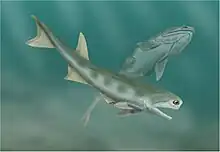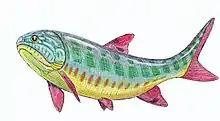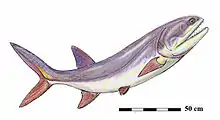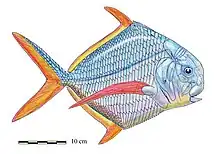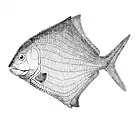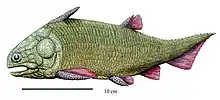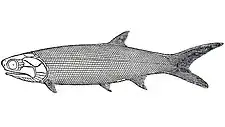| Pygopterus Temporal range: | |
|---|---|
 | |
| P. humboldti fossil (Museum of Paleontology, Tübingen) | |
| Scientific classification | |
| Kingdom: | |
| Phylum: | |
| Class: | |
| Family: | †Pygopteridae |
| Genus: | †Pygopterus Agassiz, 1833 |
| Type species | |
| †Palaeothrissium humboldti Blainville, 1818 | |
| Other species[1] | |
| |
Pygopterus is an extinct genus of prehistoric bony fish that lived during the Wuchiapingian to Olenekian ages (late Permian to Early Triassic epochs) in what is now England, Germany (Baden-Württemberg, Saxony-Anhalt), Greenland and Svalbard (Spitsbergen).[2][3] It is one of the few genera of ray-finned fish known to cross the Permian-Triassic boundary.[3]
Fossils have been found in the Marl Slate Formation, Kupferschiefer (Werra Formation), Ravnefjeld Formation, Vikinghøgda Formation and Buntsandstein.[1][2]
_(14783448315).jpg.webp)
†Pygopterus humboldti
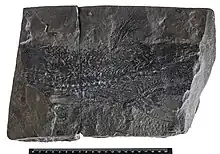
†Pygopterus humboldti fossil
Synonyms
- Pygopterus greenockii Traquair, 1866 → Nematoptychius greenockii (Traquair, 1866)[1]
See also
References
- 1 2 3 Schultze, Hans-Peter; Mickle, Kathryn E.; Poplin, Cecile; Hilton, Eric J.; Grande, Lance (2021). Handbook of Paleoichthyology, 8A. Actinopterygii I. Palaeoniscimorpha, Stem Neopterygii, Chondrostei. Dr. Friedrich Pfeil, München. p. 299. ISBN 978-3-89937-272-4.
- 1 2 Aldinger, Hermann (1937). "Permische Ganoidfische aus Ostgrönland". Meddelelser om Grønland (in German). 102 (3): 1–392.
- 1 2 Romano, Carlo; Koot, Martha B.; Kogan, Ilja; Brayard, Arnaud; Minikh, Alla V.; Brinkmann, Winand; Bucher, Hugo; Kriwet, Jürgen (2016). "Permian-Triassic Osteichthyes (bony fishes): diversity dynamics and body size evolution". Biological Reviews. 91 (1): 106–147. doi:10.1111/brv.12161. PMID 25431138. S2CID 5332637.
This article is issued from Wikipedia. The text is licensed under Creative Commons - Attribution - Sharealike. Additional terms may apply for the media files.
